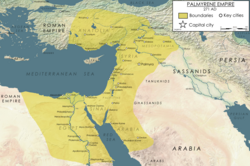Palmyrene Empire | |||||||||
|---|---|---|---|---|---|---|---|---|---|
| 260 (as kingdom)[1]/270 (as empire)–273 | |||||||||
 The Palmyrene Empire in 271 | |||||||||
| Capital | Palmyra | ||||||||
| Largest city | Alexandria[note 1] | ||||||||
| Common languages | Arabic[5] | ||||||||
| Government | Monarchy | ||||||||
| Monarch | |||||||||
• 267/270–272 | Vaballathus | ||||||||
• 272–273 | Zenobia | ||||||||
• 273 | Antiochus | ||||||||
| Historical era | Late Antiquity | ||||||||
• Established | 260 (as kingdom)[1]/270 (as empire) | ||||||||
• Disestablished | 273 | ||||||||
| |||||||||
The Palmyrene Empire was a short-lived breakaway state from the Roman Empire resulting from the Crisis of the Third Century. Named after its capital city, Palmyra, it encompassed the Roman provinces of Syria Palaestina, Arabia Petraea, and Egypt, as well as large parts of Asia Minor.
The Palmyrene Empire was ruled by Queen Zenobia, officially as regent for her son Vaballathus, who inherited the throne in 267 at age ten. In 270, Zenobia rapidly conquered most of the Roman east, attempting to maintain relations with Rome as a legitimate power. In 271, she claimed the imperial title for both herself and her son, fighting a short war with the Roman emperor Aurelian, who conquered Palmyra and captured Zenobia. A year later the Palmyrenes rebelled, which led Aurelian to raze Palmyra.
Despite its brief existence, the Palmyrene Empire is remembered for having been ruled by one of the most ambitious and powerful women in antiquity. It is also hailed in Syria, where it plays an important role as an icon in Syrian nationalism.
- ^ Vagi, David L. (2000). Coinage and History of the Roman Empire, C. 82 B.C.--A.D. 480: History. Taylor & Francis. p. 398. ISBN 978-1-57958-316-3.
- ^ Koester, Helmut (2012). History and Literature of Early Christianity. Walter de Gruyter. p. 225. ISBN 9783110812657.
- ^ Delia, Diana (1988). "The Population of Roman Alexandria". Transactions of the American Philological Association. 118: 275–292. doi:10.2307/284172. JSTOR 284172.
- ^ "Rise and fall of Palmyra, Syria". Bulletin of the Department of Geography of University of Tokyo. 27: 9. 1995.
- ^ a b c Trevor Bryce (2014). Ancient Syria: A Three Thousand Year History. OUP Oxford. p. 280. ISBN 978-0-19-964667-8.
Cite error: There are <ref group=note> tags on this page, but the references will not show without a {{reflist|group=note}} template (see the help page).